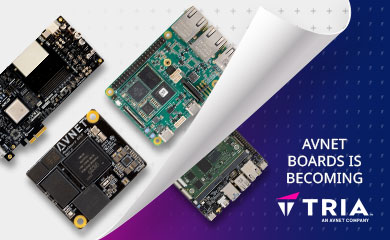Avnet creates unique solutions for phased array radar, mmWave beamforming, 5G massive MIMO and quantum computing through collaboration with industry partners AMD, Fujikura, MathWorks, Otava, Rhode & Schwarz, and Samtec.
Avnet XRF RFSoC System-on-Module
Designed for integration into deployed RF systems demanding small footprint, low power, and real-time processing. XRF modules feature the AMD Xilinx Zynq™ UltraScale+™ RFSoC with up to 16 RF-ADC and 16 RF-DAC channels and up to 6GHz analog bandwidth.
Avnet RFSoC Explorer Toolbox for MATLAB
Connect to AMD Zynq™ RFSoC evaluation boards using MATLAB®. Perform over-the-air testing with RF add-on cards. Deploy algorithms with Soc Blockset™ and HDL Coder™.
5G mmWave PAAM Development Platform
Quickly create and prototype advanced 5G mmWave systems using the AMD Zynq™ UltraScale+™ RFSoC Gen3 and Fujikura’s 28GHz FutureAcess™ Phased Array Antenna Module (PAAM).

Ground-breaking wideband mmWave beamforming
Otava’s Beamformer IC (BFIC), the OTBF103, is a mmWave wideband time-division-duplexing beamformer with 8 transmit and 8 receive channels in the 24 GHz to 40 GHz frequency range. The Avnet Otava Beamformer IC Evaluation Kit allows for the rapid evaluation of this ground-breaking device.
Recent tradeshows, webinars, and white papers
- International Microwave Symposium 2023 – recordings live from the event, Avnet presented three workshops and showcased five solutions in conjunction with AMD, Otava, Fujikura, MathWorks, Samtec and Rhode & Schwarz
- AMD Zynq™ RFSoC in mmWave Training Series – learn practical design techniques including frequency-planning, multi-channel data converter synchronization, and advanced test and measurement solutions for 5G FR2 mmWave bands
- Beamforming: Fundamentals to Implementing – an introduction to fundamental beamforming theory for phased array systems and its implementation in AMD Zynq™ UltraScale+™ RFSoC
- Dive deeper into 5G: From the interconnect design challenges of 5G to preparing now for 6G, what will it take to build the networks of the future to enable your vision? Explore the key characteristics of almost limitless connectivity in any context.
Videos


Prototype 5G FR2 with the AMD Zynq™ RFSoC DFE and mmWave Phased Array
Engineers from Avnet, AMD and Rohde & Schwarz describe a new 5G FR2 phased array antenna-to-bits development system and demonstrate automated OTA measurements using a CATR benchtop antenna test system.

Optimizing EVM Measurements in 5G FR2 Phased Array Antenna Modules
Learn RF measurement techniques for optimal OTA wireless link performance using the R&S® ATS800B CATR benchtop antenna test system. The device-under-test combines the AMD Zynq™ RFSoC DFE, MATLAB-based 5G NR signal generation, and beamforming through the Fujikura FutureAccess™ mmWave phased array antenna module.